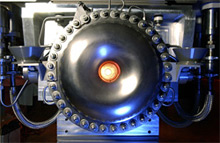Intensity Frontier
Particle physics experiments at the Intensity Frontier explore fundamental particles and forces of nature using intense particle beams and highly sensitive detectors. One of the ways that researchers search for signals of new physics is to observe rarely interacting particles, such as neutrinos, and their corresponding antimatter particles. Some of these experiments search for evidence of the process theorists hypothesize allowed our universe full of matter to bloom rather than being annihilated by an equal amount of antimatter created in the big bang. Other experiments seek to observe rare processes that can give researchers a glimpse of unknown particles and unobserved interactions.
Neutrino Physics
Neutrinos are some of the most fascinating of the known particles. They abound in the universe but interact so little with other particles that trillions of them pass through our bodies each second without leaving a trace.
Neutrinos come in three types, called flavors: muon, electron and tau. They have no electric charge. Their mass is so small that the heaviest neutrino is at least a million times lighter than the lightest charged particle.
At Fermilab, physicists use a beam of protons from the Main Injector accelerator to create the most intense high-energy neutrino beam in the world. Magnets direct the protons onto a graphite target. When the protons strike this target, they take the form of new particles called pions. A magnetic lens called a horn focuses and collects the positively charged pions and discards the negatively charged ones. The positively charged pions travel through a long, empty space and ultimately decay into antimuons and muon neutrinos. Experimentalists filter the resulting mix of debris, antimuons, undecayed pions and muon neutrinos through a steel and concrete absorber, which stops all but the weakly interacting neutrinos. To make a beam of antineutrinos, they reverse the magnetic field of the horn to collect negatively charged pions that decay to negatively charged muons and muon antineutrinos.
The facility that creates Fermilab's neutrino beam is called NuMI, for Neutrinos at the Main Injector. The neutrinos travel between two detectors for an experiment called MINOS, or Main Injector Neutrino Oscillation Search. One sits at Fermilab; the other is located 450 miles away in the Soudan Underground Laboratory in Minnesota. The NuMI Beamline is aimed downward at a 3.3 degree angle toward the underground laboratory. Neutrinos interact so rarely with other particles that they can pass untouched through the entire Earth.
Although the beam starts out at 150 feet below ground at Fermilab, it passes as much as 6 miles beneath the surface as it travels through the earth toward Soudan. Neutrinos travel at the speed of light and make the trip from Illinois to Minnesota in just two and a half thousandths of a second. Researchers at Fermilab use the NuMI beamline as a source of neutrinos for other intensity-frontier experiments as well.
Muon Physics
Muons are the heavy cousins of electrons. They have the same electric charge and interact with matter in a similar way: muons and electrons belong to the same family of particles known as leptons. Unlike protons, which comprise subatomic particles called quarks, muons and electrons come in one piece: they are elementary particles.
Muons could eliminate a big problem that scientists face when accelerating electrons: in a circular accelerator, electrons emit light and lose energy as they go around the ring. This puts a limit on the maximum energy that the electrons can reach in such a machine.
Because muons are 200 times heavier than electrons, they emit less light and lose less energy when traveling in a circle than electrons do. Hence scientists are developing the concept of a circular muon accelerator. Sending the muons through the same loop and the same accelerating cavities repeatedly reduces the number of cavities needed and the footprint necessary to accommodate a collider.



